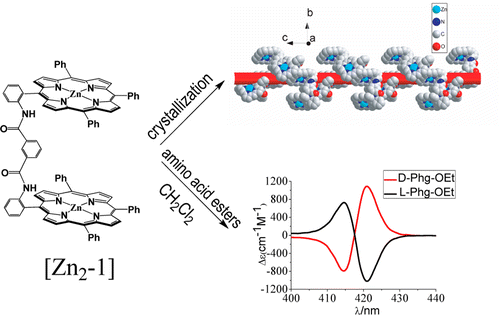m-Phthalic Diamide-Linked Zinc Bisporphyrinate: Spontaneous Resolution of Its Crystals and Its Application in Chiral Recognition of Amino Acid Esters
Jiaxun Jiang †, Xianshi Fang †, Baozhen Liu †, and Chuanjiang Hu *†‡(胡传江)
† Key Laboratory of Organic Synthesis of Jiangsu Province, College of Chemistry, Chemical Engineering and Materials Science, Soochow University, Suzhou 215123, P. R. China
‡ State Key Laboratory & Coordination Chemistry Institute, Nanjing University, Nanjing 210093, P. R. China
Inorg. Chem. 2014, 53, 3298–3306
A novel m-phthalic diamide-linked zinc bisporphyrinate [Zn2-1] has been designed and synthesized. Its chiral crystalline samples have been spontaneously resolved by crystallization. Data for C48H29N5OZn follow: tetragonal, I41, a = 17.809(2) Å, b = 17.809(2) Å, c = 27.080(8) Å, V = 8589 (3) Å3, Z = 8. X-ray crystallography reveals the two porphyrin subunits are clockwise arranged in the solved structure. Each zinc atom is coordinated by four pyrrole nitrogens and the amide oxygen of the neighboring molecule. Through coordination bonds, it forms a helical chain with P configuration along the c axis. The overall crystal forms an unprecedented chiral bisporphyin coordination polymer. The chirality of the single crystals has been confirmed by CD spectroscopy. UV–vis and NMR spectroscopic studies suggested the molecule aggregates in solution. Such m-phthalic diamide-linked zinc bisporphyrinate shows a strong chiral recognition ability for amino acid ethyl esters. The amplitude value of the induced circular dichroism (ICD) (

链接: //pubs.acs.org/doi/abs/10.1021/ic401949e